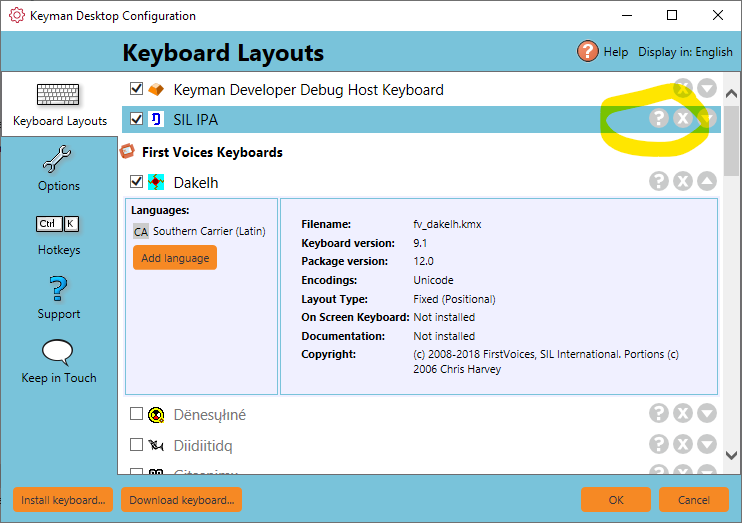This question was sent to the writing systems help desk from Christopher J Samuel. No email address was included. Any comments?
He says, I have discovered that the “Polytonic Greek (SIL)” keyboard outputs vowels with tonos. My understanding was that tonos is appropriate for the monotonic system of modern Greek, with precomposed characters in the main Greek block (u03xy), whereas the polytonic system of ancient Greek uses oxia for the acute accent, with precomposed characters in the extended Greek block (u1fxy).
The keyboard was updated over a year ago for the new Keyman repo, but the actual keystrokes and output haven’t been changed in years as far as I know.
I will check into it, but I’m not going to be able to do anything for at least a week. Sorry 
Hi, I am just discovering Unicode for Greek and Hebrew. It is a bit unsettling at first (which is right now for me), but I get that I have to pass through the keyboards in the Input menu bar of my Mac. Then I can “clothe” what has been written with a nice font. But I write this message in order to know if there is anything like a chart for vowels and accents as there is for the main characters in Greek. The pictures about these (below the two main charts) are rather enigmatic and not corresponding to the real place they occupy in the Keyboard viewer as well as on the file I write in. I mean the charts for Greek -Polytonic.
If you are referring to this keyboard: https://keyman.com/keyboards/sil_greek_polytonic you can click on the documentation link on that page and it will show you a keyboard chart and then a chart of keystrokes. Is that what you are needing?
Also, there is usually a welcome.htm file that is displayed when you install a Keyman keyboard package.
If you want to go back and look at the welcome.htm file after you’ve installed it, on my machine (Windows 10) it puts it here:
C:\ProgramData\Keyman\Keyman Engine\Keyboard\_Package\sil_greek_polytonic\welcome.htm
Other ways to access the documentation are:
-
Start Keyman Configuration, and click the
(?)icon shown to the right of the keyboard name: -
While the keyboard is active, click the Keyman icon in the System Notification area (it might be hidden under the
^button down near the clock) – the icon will look like the icon for the keyboard – and select Help; or click the help icon in the On Screen Keyboard, and select the option for help on the active keyboard.
Thank you. The charts ofr the vowels and accents are an enigma to a normal person.
Best regards
The Unicode Standard says (https://www.unicode.org/versions/Unicode12.0.0/ch07.pdf, p. 304): “The basic Greek accent written in modern Greek is called tonos. It is represented by an acute accent (U+0301). The shape that the acute accent takes over Greek letters is generally steeper than that shown over Latin letters in Western European typographic traditions, and in earlier editions of this standard was mistakenly shown as a vertical line over the vowel. Polytonic Greek has several contrastive accents, and the accent, or tonos, written with an acute accent is referred to as oxia, in contrast to the varia, which is written with a grave accent.”
Although it may not become clear from this, tonos and oxia are one and the same as far as encoding is concerned. If you look at https://www.unicode.org/charts/PDF/U0300.pdf, under 0301 COMBINING ACUTE ACCENT, the comments state “= Greek oxia, tonos”. That makes the tonos/oxia identity absolutely clear. A font designer may decide to apply a different shape to the accent in precomposed glyphs, depending on whether they are defined as glyphs with tonos or with oxia, but that has no bearing on the encoding. Most fonts containing both monotonic and polytonic characters do not seem to make a visual distinction nowadays.
As to the choice of precomposed character as the output of a keyboard: they are “canonically equivalent,” so I do not think it matters. If I take precomposed lowercase alpha plus tonos and lowercase alpha plus oxia (U+03AC and U+1F71) and then normalize to Form D (“decomposed”), they both become U+03B1.0301. Normalizing them back to Normalization Form C (“precomposed”) gives U+03AC in both cases. The Unicode preference therefore is for the “tonos” code points. But keyboard designers are perfectly entitled to give preference to the “oxia” code points if they so desire. Unlike some other Greek characters, the “oxia” precomposed characters are not officially deprecated (or their use “discouraged”).
In conclusion: the “Polytonic Greek (SIL)” keyboard outputting vowels with tonos for ancient Greek vowels with “oxia” is consistent with recommended practice. Fonts do not normally distinguish the two kinds of precomposed characters visually, so there is little reason to depart from this practice.
Hope this helps. Sorry for the long post!
